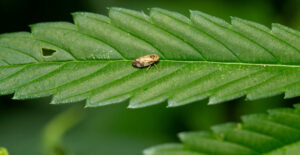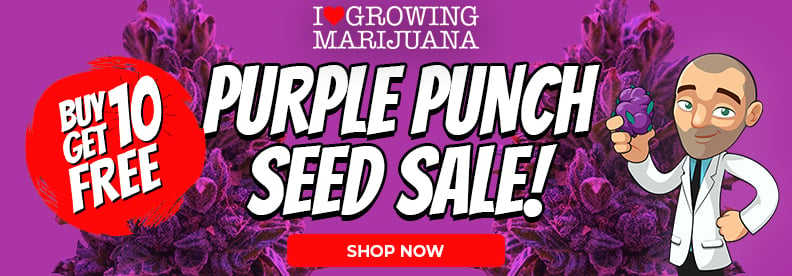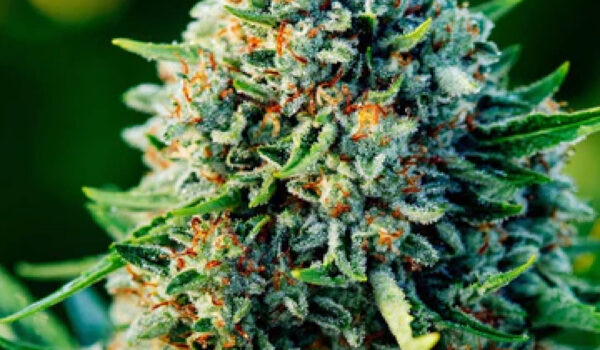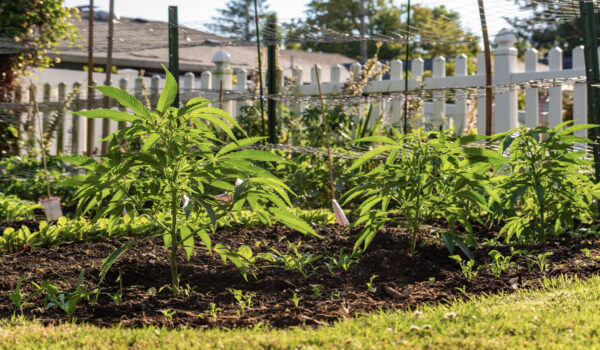by Rincon-Vitova Insectary
Leafhoppers

Leafhoppers feed on leaves and stems with piercing sucking mouthparts that extract a bit of fluid from the plant. Most have insignificant effects. A few species cause small, light flecking/stippling injury may occur at the feeding site. Black sooty mold is a secondary outbreak from their honeydew. Although some leafhoppers transmit plant pathogens that cause diseases of crops none of these leafhopper-vectored plant diseases are presently known to affect hemp.
Identification
Leafhopper adults are slender, wedge-shaped, and less than or about equal to 1/4-inch long.
They have varying colors; some species are brightly colored, while others blend with their host plant.
Leafhoppers are quite active; they crawl rapidly sideways or readily jump when disturbed.
Sometimes leafhoppers can be confused with aphids or lygus bugs:
Lygus can be identified by their red-tipped antennae.
Aphids can be distinguished by two “tailpipe” structures (cornicles) protruding from their hind end.
1 or more long rows of spines on the hind legs distinguish leafhoppers from most other insects they may resemble.
Life Cycle
Females insert tiny eggs in tender plant tissue, causing pimple-like injuries.
Leafhoppers overwinter as eggs on twigs or as adults in protected places such as bark crevices.
In cold-winter climates, leafhoppers may die during winter and in spring migrate back in from warmer regions.
Egg to adult is approximately 3 weeks. Several overlapping generations may occur during the growing season.
Monitoring
Leafhoppers are often more present in dry weather, looking for moisture from plants.
Look for adults, nymphs, and their pale cast skins on the underside of leaves.
Black spots of excrement and cast skins may be present on leaves and/or fruit.
Damage shows as pale or brown stippling. Shoots may curl and die. Some leafhoppers cause diamond-shape yellowing from the leaf tip.
A few species secrete honeydew, which often leads to black sooty mold growth.
If honeydew/sooty mold is present, be diligent watching for ants.
Cultural Practices
Low risk materials applied to infested foliage reduces numbers of nymphs – thorough coverage of undersides is critical.
Insecticidal soap: fatty acid salts weaken the cuticle (exoskeleton), and won’t leave a harmful residue.
To help the soap penetrate the insects’ outer shell, mix 1 Tbs of isopropyl alcohol to 1 Qt of the spray.
Dust with Diatomaceous Earth: these jagged particles cut the insects and expose to desiccation & disease. It will need to be reapplied as it gets wet.
Narrow-range oils: smother pests by coating their spiracles (breathing holes)
Bordeaux mixture (copper sulfate & slaked lime = fungicide) can repel adults and act as antifeedant.
Neem oil – not for flowering plants (will leave smell/taste on buds)
Neem Oil (Azadirachtin): mimics IGRs: primarily kills immature insects (they fail to complete molts). It also acts as an antifeedant & repellant. Neem is less effective on aphids & some grasshoppers. Neem also breaks down in water – don’t mix more than needed. It persists 4-8 days as foliar spray, and weeks if drenched. Neem does not harm foraging bees.
Habitat enhancement: strip of alfalfa, corn, pea provide nutrition
Avoid using pesticides: Neonicotinoids (imidacloprid), Organophosphates (acephate), Carbamates, (carbaryl). These materials are highly toxic to natural enemies and pollinators.
Leafhoppers Bio-Control
Beauveria bassiana (for aphids, thrips, WF)
68-86 °F >92% RH
An entomopathogenic fungus wide host range, including soft-bodied beneficials
Best for sap-sucking & chewing insects
Spores germinte on insects – kill in 2-10 days
Some strains have 3-7 day residual activity
Weekly applications can prevent insect population explosions
Application Rates: Application Rates may vary among different commercial products. Read labels carefully.
½ to 2 qt per 100 gallons for liquid emulsion suspension products
½ to 2 lbs per 100 gallons for wettable powder products
Weekly applications can prevent insect population explosions
Metarhizium anisopliae
Fungal pathogen penetrates skin, enters spiracles
Infected insects stop feeding and die in 4-10 days
Works best against sap-sucking insects, like whiteflies and aphids (other strains for thrips, beetles)
Best in high humidity and moderate temps: 75-82°F
Application Rates: Application Rates may vary among different commercial products. Read labels carefully.
40-80 oz per 100 gallons of water as a drench
8–64 oz per 1 acre as a foliar spray
Generalist Predators:
Hippodamia convergens
Ladybugs – will feed on eggs and immature stages both as adults and larvae.
Often leave after released
Application Rates:
1 beetle per sq ft.
Reapply if necessary
Chrysoperla rufilabris
Green Lacewing – generalist
Wingless predator for 2-3 weeks
Will focus on eggs and immature stages, but can catch adults
Application Rates: 1,000 eggs per 2,500 sq ft or 5,000-10,000 per acre
Eggs on Cards: hang 1-2 units/bush, 1-5 units tree
Pre-hatched Larvae: 20/bush, 100/tree
Reapply every two weeks to suppress populations, monthly for maintenance
Summary of Strategies
Dust with DE/kaolin clay preventively
Plant habitat to attract native beneficials (Like Orius)
Ant Control
Low risk “soft pesticides:” Insecticidal soap, Neem/Hort oil
Beauveria bassiana
Metarhizium
Augment with beneficials: Green lacewing and Ladybugs


